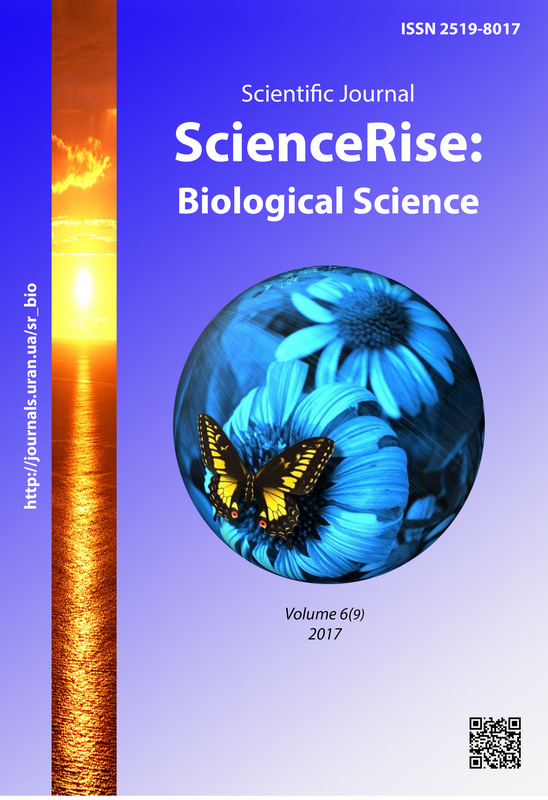Hematological indicators of rats for artificial hypobiosis
DOI:
https://doi.org/10.15587/2519-8025.2017.118786Keywords:
hypobiosis, hypercapnia, hypoxia, erythrocyte, lymphocyte, platelet, blood, rats, hematology, leucocyteAbstract
The use of hypobiotic state in the medical practice is rather urgent in the modern world. Three most important conditions of creation of artificial hypobiosis are: hypoxia, hypothermia and hypercapnia. The most important parameters that characterize homeostasis of the organism at artificially created conditions of hypobiosis are hematological indices. White non-pedigreed male rats with the mass 180–200 g, kept in standard vivarium conditions, were used for the experiment. Animals were divided in groups: control (intact animals) and experimental ones – the first group (artificial hypobiosis), the second group in 24 hours after going out from artificial hypobiosis. The number of animals in each group n=5. Experiments were realized according to requirements of the “European convention about protection of vertebral animals, used for experimental and other scientific needs” (Strasburg, France, 1985), general ethic principles of experiments on animals, accepted by the First national congress of Ukraine on bioethics (2001). As a result of realized studies there was demonstrated the essential increase of erythrocytes and platelets together with the decrease of the leycocytes content. Under conditions of hypoxia and hypercapnia the growth of the erythrocytes level can be explained by the increase of the carbonic acid level, and the platelets level grows because of the decrease of blood fluidity at artificial hypobiosis
References
- Aslami, H., Juffermans, N. P. (2010). Induction of a hypometabolic state during critical illness – a new concept in the ICU? The journal of medicine, 68 (5), 190–198.
- Nelson, D. L., Cox, M. M. (2008). Lehninger Principles of Biochemistry. New York: W. H. Freeman, 1100.
- Storey, K. B. (2002). Life in the slow lane: molecular mechanisms of estivation. Comparative Biochemistry and Physiology Part A: Molecular & Integrative Physiology, 133 (3), 733–754. doi: 10.1016/s1095-6433(02)00206-4
- Zhenyin, T., Zhaoyang, Z., Cheng, C. L. (2011). 5′-Adenosine monophosphate induced hypothermia reduces early stage myocardial ischemia/reperfusion injury in a mouse model. American Journal of Translational Research, 3 (4), 351–361.
- Wilz, M., Heldmaier, G. (2000). Comparison of hibernation, estivation and daily torpor in the edible dormouse, Glis glis. Journal of Comparative Physiology B: Biochemical, Systemic, and Environmental Physiology, 170 (7), 511–521. doi: 10.1007/s003600000129
- Alukhin, Yu. S., Ivanov, K. P. (1998). A model of winter hibernation in a non-mammalian mammal upon cooling its brain to 1–4 °C. Adapt. organism to nature. and eco-sots. environmental conditions. Magadan, 6–7.
- Vykhovanets, V. I., Melnychuk, S. D. (2008). History of the development of models of artificial suppression of living organisms. Scientific herald of NAU, 127, 65–68.
- Kalabukhov, N. I. (1985). Hibernation of mammals. Moscow: Science, 168.
- Melnichuk, S. D., Vakhovets, V. I. (2005). The Influence of the Conditions of the Artificial Hypobiosis on the Energy Exchange in Rats. Ukrainian Biochemical Journal, 77 (3), 131–135.
- Melnichuk, S. D., Melnychuk, D. O. (2007). Animal hypobiosis (molecular mechanisms and practical values for agriculture and medicine). Kyiv: Publishing Center of NAU, 220.
- Melnichuk, D. O., Melnichuk, S. D., Arnauta, O. V. (2004). Influence of the carbon dioxide medium on the preservation of erythrocytes in the canned blood of animals. Scientific Herald NAU, 75, 163–165.
- Melnichuk, S. D. (2001). Basic indicators of acid-base blood and metabolic processes in the case of hypobiosis and general anesthesia for amputation of the limb. Ukrainian Biochemical Journal, 73 (6), 80–83.
- Melnichuk, S. D., Rogovsky, S. P., Melnychuk, D. O. (1995). Features of acid-base equilibrium and nitrogen exchange in the body of rats under conditions of artificial gipobiosis. Ukrainian Biochemical Journal, 67 (4), 67–75.
- Melnichuk, S. D., Vychanets, V. I. (2005). The Influence of Conditions of Artificial Hypobiosis on Energy Exchange in Rats. Ukrainian Biochemical Journal, 11 (3), 131–135.
- Severina, E. S. (Ed.) (2004). Biochemistry. Moscow: GEOTAR-MED,784.
- Skulachev, V. P., Bogachev, A. V., Kasparinskiy, F. O. (2010). Membrane energy. Moscow: Publishing house of the Moscow University, 368.
Downloads
Published
How to Cite
Issue
Section
License
Copyright (c) 2017 Anna Umanska, Dmytro Melnichuk, Lilia Kalachnyuk

This work is licensed under a Creative Commons Attribution 4.0 International License.
Our journal abides by the Creative Commons CC BY copyright rights and permissions for open access journals.
Authors, who are published in this journal, agree to the following conditions:
1. The authors reserve the right to authorship of the work and pass the first publication right of this work to the journal under the terms of a Creative Commons CC BY, which allows others to freely distribute the published research with the obligatory reference to the authors of the original work and the first publication of the work in this journal.
2. The authors have the right to conclude separate supplement agreements that relate to non-exclusive work distribution in the form in which it has been published by the journal (for example, to upload the work to the online storage of the journal or publish it as part of a monograph), provided that the reference to the first publication of the work in this journal is included.









